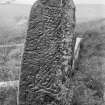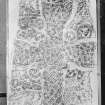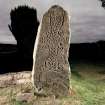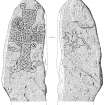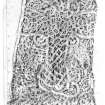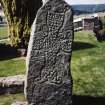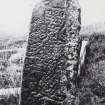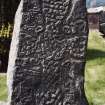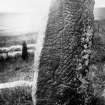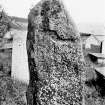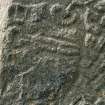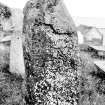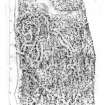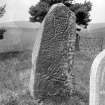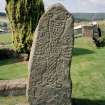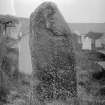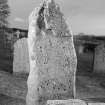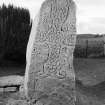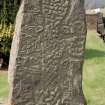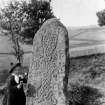Migvie Churchyard, Symbol Stone
Cross Slab (9th Century), Pictish Symbol Stone (Pictish)
Site Name Migvie Churchyard, Symbol Stone
Classification Cross Slab (9th Century), Pictish Symbol Stone (Pictish)
Alternative Name(s) St Finan's Church; St Finnan's Church; Migvie, Old Parish Church; Migvie Parish Church
Canmore ID 288643
Site Number NJ40NW 2.02
NGR NJ 43652 06822
Datum OSGB36 - NGR
Permalink http://canmore.org.uk/site/288643
- Council Aberdeenshire
- Parish Logie-coldstone
- Former Region Grampian
- Former District Kincardine And Deeside
- Former County Aberdeenshire
Migvie 1 (St Finan), Aberdeenshire, Pictish cross-slab
Measurements: H 1.75m above ground, W 0.75m, D 0.33m
Stone type: gneiss
Place of discovery: NJ 4365 0682
Present location: set upright in the kirkyard.
Evidence for discovery: found during grave-digging in the kirkyard around 1861.
Present condition: weathered.
Description
This irregularly shaped slab is carved in a mixture of relief and incision. On face A there is a relief cross formed of fat median-incised interlace, with strap-and-buckle shaped projections at the junctions of the arms and at the corners of the upper arm. Two S-shaped figures spring from the foot of the shaft. Above the left arm is a double disc and Z-rod symbol, above the right arm a unique arch (or horseshoe) and V-rod, and below the left arm a pair of shears. Near the base of the cross-shaft on the right is a horseman facing the cross, and there is another horseman incised on face C, the horse showing the same gait and also facing left.
Date: ninth century.
References: ECMS pt 3, 191-3; Fraser 2008, no 34.
Desk-based information compiled by A Ritchie 2017
Field Visit (4 September 1968)
All that can be seen of the old church is a slight mound with grass-covered footings about 6.0m wide and of indefinite length.
The symbol stone is as described.
Another inscribed cross-stone lies against the S wall of the modern church. It is roughly triangular measuring 0.4m high, 0.3m wide and 0.1m thick. No further information could be obtained about it.
Surveyed at 1/2500.
Visited by OS (N K B) 4 September 1968.
Publication Account (1986)
A roughly pointed pillar of gneiss, 2.1m tall, bearing n one face a cross and on the back a horse and rider. As at nearby Kinord (no. 58), the cross fills the stone; it has, however, been carved with much less skill. In particular, the arms of the cross have been crammed in and the knot work in the top panel is distinctly jumbled. The cross is a waisted form, defmed by a crude channel and filled with low-relief plait work. There are curious circular projections at the top and angles of the cross which perhaps suggest the suspension loops of a metal cross; two curves extend from the base in the manner of the scrolls at Kinord.
In the angles of the cross are three symbols and a horse and rider. The former are extremely small and rather crude; they comprise a horseshoe (rather than a crescent) and V-rod, a double disc and Z-rod and a pair of shears. The first and last symbols are unique to Aberdeenshire and may be very late. This, and the generally inferior quality of the carvings have led some scholars to suggest that this stone may have been sculpted later even than the Kinord cross (no. 58). It is, nonetheless, an oddly moving monument.
Information from ‘Exploring Scotland’s Heritage: Grampian’, (1986).
Publication Account (1996)
A roughly pointed pillar of gneiss, 2.1m tall, bearing on one face a cross and on the back a horse and rider. As at nearby Kinord (no. 58), the cross fills the stone; it has, however, been carved with much less skill. In particular, the arms of the cross have been crammed in and the knot work in the top panel is distinctly jumbled. The cross is a waisted form, defined by a crude channel and filled with low-relief plait work. There are curious circular projections at the top and angles of the cross which perhaps suggest the suspension loops of a metal cross; two curves extend from the base in the manner of the scrolls at Kinord.
In the angles of the cross are three symbols and a horse and rider. The former are extremely small and rather crude; they comprise a horseshoe (rather than a crescent) and V-rod, a double disc and Z-rod and a pair of shears. The first and last symbols are unique to Aberdeenshire and may be very late. T his, and the genera lly inferior quality of the carvings have led some scholars to suggest that this stone may have been sculpted later even than the Kinord cross (no. 58). It is, nonetheless, an oddly moving monument.
Information from ‘Exploring Scotland’s Heritage: Aberdeen and North-East Scotland’, (1996).
Reference (1997)
Class II symbol stone. The Cross face shows four quadrants : upper left shows a double-disc and Z-rod,upper right a horseshoe and V-rod,lower left has shears and in the lower right is a mounted figure. On the reverse is another mounted figure.
A Mack 1997; (Undated) information in NMRS.
Archaeological Evaluation (April 2019 - May 2019)
NJ 43604 06819 In the summer of 2018, aerial photography identified a curving cropmark surrounding the parish church and Pictish symbol stone at Migvie (Canmore ID: 288643). On 29 April 2019 an electrical resistivity survey was carried out in the fields surrounding the church to the east, north and west. Despite the complicated geology a feature was discovered surrounding the church site, appearing in both surveys and showing an oval enclosure around the church. In May 2019 a small trench measuring 5m by 1m was opened over the geophysical response to the south of the church. The excavation revealed a small, 1.5m wide ditch no more than 0.4m in depth. Soil samples from its fill were taken, with charcoal from basal samples returning a date of cal AD 650-770.
Archive: University of Aberdeen
Funder: University of Aberdeen
Gordon Noble, James O’Driscoll and Leidy Gonzalez – University of Aberdeen
(Source: DES Vol 20)
Note
Not to be confused with cross slab within Kirkhill burial ground (at NJ 43247 05646), for which see NJ40NW 5.01.



























